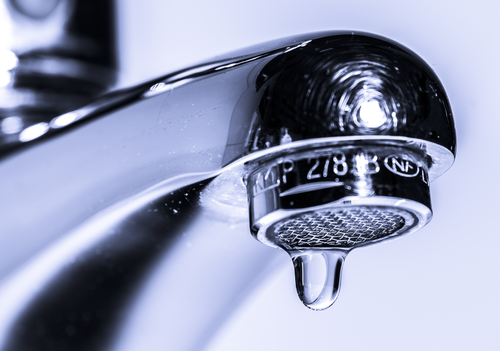Install Low Flow
Replacing old water fixtures with low-flow models like toilets, showerheads, and faucets can pay for itself in water and energy savings. If everyone in the U.S. installed low flow showerheads, it would save over $5 billion in water and heating costs!
Your Impact
Action Steps & Tips
Introduction

Installing low-flow showerheads, faucets, and toilets is a fast and easy way to save water and money. Toilets alone are one of the biggest water users in the house, gobbling up over 25% of all indoor household water use. Making the switch to low-flow toilets can save over 10,000 gallons of water a year for a family of four.
Going low-flow does not mean low pressure or reduced functionality. There are three main ways to go low flow with your showerhead, faucets, and toilets. Faucets and showerheads are easy to replace and can generally be done yourself. Toilets are a bit more complicated and it’s generally better to hire a professional. Read on for more information on each one.
When purchasing, always look for the WaterSense label! WaterSense is the water equivalent of Energy Star and the best choice for efficiency.
Installing low-flow:
-
Saves precious water resources, energy and money
-
Is low cost and easy to install
-
Reduces climate and air pollution
1Install low flow showerheads
Showering is one of the top home water uses, responsible for over 15% of indoor water use. Installing a low flow showerhead is easy to do and can save significantly on both water and energy use. A low flow showerhead does not reduce the pressure, only the flow rate, so you should still be able to enjoy a good shower.
Low cost, big savings. Depending on which model you purchase, a low-flow showerhead can have a flow rate of 2.0 gallons per minute or less. Low-flow showerheads don’t have to be expensive—they cost $20-$50 or more and pay for themselves quickly. The average family can save up to 3,000 gallons of water and $50 a year by switching from a regular shower head to a low flow!
Determine if you need to install a low flow showerhead. Test your current showerhead to see if you would benefit from a low flow showerhead. Get a bucket and place a mark at the one-gallon line. Turn the shower on to your preferred pressure, then place the bucket under the water. Now, count the seconds it takes to reach the mark. If it takes less than 20 seconds to hit the mark, you will benefit from switching to a low-flow.
Purchase and install your new showerhead. Installing a new low-flow showerhead is easy and you can probably do the job yourself. Check out this video on how to do the install.
2Install low flow faucets or aerators
A faucet aerator is a small round device that screws into the end of your faucet, right where the water comes out, and reduces the water flow. Faucet aerators are low cost, easy to install and save a lot of water!
Check your aerators. If you have aerators now on your faucets, check to make sure they are working properly. If the water is running slow or the faucet seems to not be working properly, this could be because the aerator is broken or clogged. It is easy to clean them out if clogged, however, if they are damaged it is much easier to replace than repair. If your aerators are old, installing a new one will likely save water and improve your water flow.
This is a very low cost action, as most faucet aerators cost around $5-$10 each and could save up to 30% of your water use in the kitchen and bathroom. This saves money on both your water and water heating bill and will pay for itself in a short period of time.
Replace or add aerators. Faucet aerators are very easy to replace and install. Simply unscrew the old one and take it to your local hardware store to find the correct replacement. They come in different sizes, flow rates, and some thread types. Make sure you purchase the correct one for your faucet. When removing the old aerator, make sure to also remove the rubber gasket inside or the new one will not fit! Here is a video on installing a faucet aerator.
3Install low flow toilets
Toilets are the biggest water user in the house. While older toilets can use up to 6 gallons per flush, newer higher-efficiency toilets use 1.6 gallons or less! If you have older toilets, you can save up to $100 a year on water costs if you replace them with low-flow toilets. Since toilets last a long time, you will enjoy this annual savings for many years! Here are some tips on upgrading:
Determine if your current toilets are low-flow. Starting in 1994, all new toilets were required to use no more than 1.6 gallons per flush. If your toilets are older than 1994, they should likely be replaced. However, if you’re not sure when they were installed, look in the tank for a make and model number and look it up online or call the manufacturer.
Purchase and install your new toilet. There are a few different kinds of low-flow toilets, including dual-flush models which allow you to choose one button that uses less water for liquids and one for solid waste. It is recommended to have a plumber do the install, and they can also help you choose the best toilet for your home.
A new toilet generally costs from $200-$400 or more. Don't forget to budget in around $100-$200 per toilet for professional installation. Make sure to choose a WaterSense labeled toilet!
Additional water savings tip. If you can’t afford new toilets now or if you just want to further improve the efficiency of your low-flow toilet, there are a couple of tricks to try. Placing a small, filled water bottle with the cap on or a small fake brick into the tank for water displacement can save water. Don’t use a real brick—they can erode causing a blockage in your toilet! Consult a professional to make sure this will work for your specific model of toilet.

